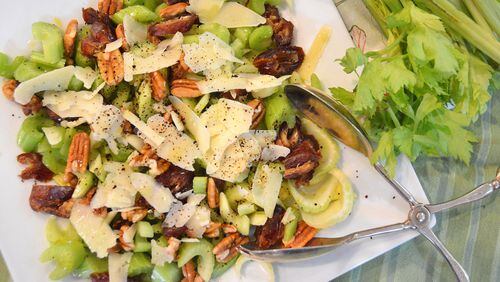Celery is one of the mainstays of the vegetable crisper. Like onions, carrots and potatoes, celery can seem quite seasonless, and certainly somewhere in the world, a field of celery is being harvested most any day of the year.
Sadly, for Megan Busby of Shoot Farm in Randolph County, Alabama, four miles from the Georgia state line, this is not the year she’ll be harvesting much celery. Her cherry tomatoes did fine, her cantaloupe did well and she had a bumper crop of basil. But celery? Not so much.
Last year Busby experimented with celery for the first time and was successful enough that she was primed to grow it again this year. She selected “Tango,” a variety that’s heat tolerant and tough enough to grow in our climate. Or so she hoped.
“This year with so much rain and then heat, out of the 125 plants I put in, only about 10 or 12 survived. It likes even moisture, but it doesn’t like to be super wet. And I also learned that it doesn’t like clay. A clay soil keeps in too much moisture.”
Busby started her plants in her greenhouse. The seeds went into two-inch soil blocks and after four or five weeks, the little plants were ready to go into the ground. She transplanted them into the fields in early August.
“One of the other problems with celery is that it has such a long growing period, if your crop doesn’t turn out well, you don’t have time to start another one since you really can’t start your seed until early July.”
Of her dozen or so surviving plants, she expects to be bringing them to market about now, mid-October. You can find her on Saturday mornings at the Peachtree City Farmers Market.
When she grew celery last year her customers were delighted to buy it. “They were surprised when they saw it but they bought it. They sure did.”
Field-grown or even greenhouse-grown celery harvested here in the South is intensely fragrant. If a farmer has it in her booth, shoppers are going to be drawn in by the fragrance alone. Busby lets her customers know this is pretty strong stuff.
“I recommend they cut it into small pieces when they’re using it. The flavor is delicious, but maybe you’d use a little less than your recipe calls for.”
If you’re lucky enough to find a farmer who did well with celery this year, buy all you can. Use it fresh and then what you can’t use right away, freeze. Sauté it by itself or cook up a batch of classic French mirepoix (onions, carrots and celery) or the Cajun version with onions, peppers and celery and freeze recipe-size quantities. And don’t discard the leaves which are just as flavorful as the stalks. The leaves and any stalk trimmings should go into a freezer bag for the next time you’re making chicken or beef stock.
FOR SALE AT LOCAL FARMERS MARKETS
Just coming to market: celery, Napa cabbage, roselle, turmeric
Vegetables, nuts and fruits: apples, arugula, Asian greens, Asian pears, beets, cabbage, carrots, chard, collards, cornmeal, cucumbers, eggplant, garlic, ginger, green and pole beans, grits, herbs, kale, lettuce, melons, microgreens, muscadines, mushrooms, mustard greens, okra, onions, pecans, pears, peppers, polenta, potatoes, radishes, spaghetti squash, sweet potatoes, tomatoes, turnips, winter squash
From local reports






